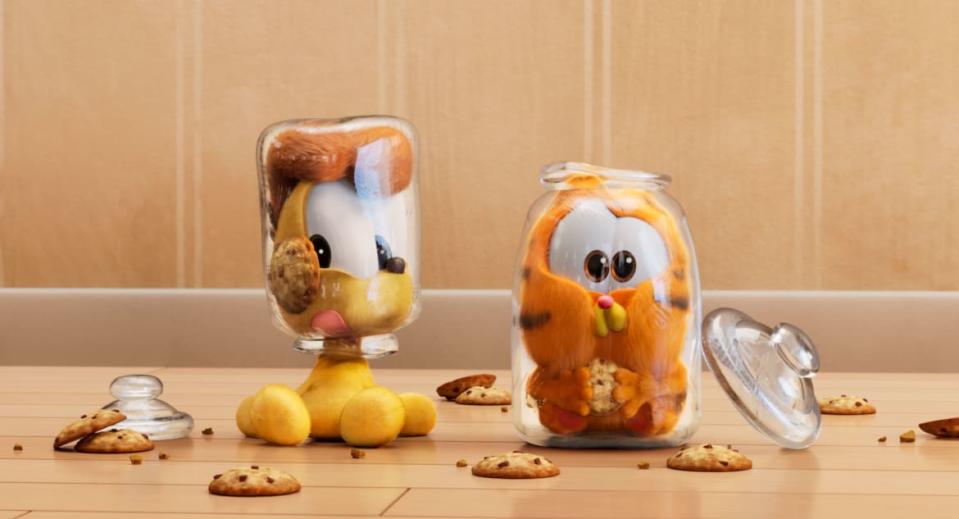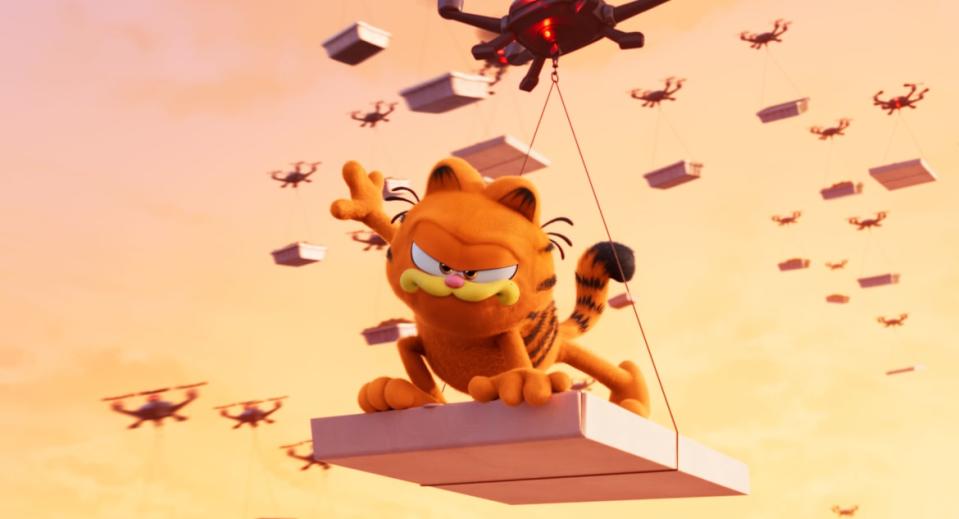The ‘Garfield Movie’ Product Placement Is So Very Depressing

Lasagna is not healthy. You can hear the sound of hundreds of meat tenderizers slapping the palms of some angry Italian hands right now, but it’s true. Even a cat like Garfield, who adores lasagna, is acutely aware of this. But much like pulling the blanket back over his head after his Monday morning alarm goes off, chowing down on lasagna is one thing that the plump orange tabby is reluctant to give up. I’m not a veterinarian (too sad), but all that saturated fat can’t be good for him!
Perhaps that’s why, in The Garfield Movie, Garfield is trying to cut back on his cholesterol and fats. Yet, it’s hammered over the viewers’ heads from the opening scene that this stout little guy still loves his baked pasta, so much so that he can’t stop maxing out his owner Jon Arbuckle’s credit card to place delivery orders. That’s why, when Garfield saddles up next to a big bag of cheddar-flavored Popchips—a “healthier choice” snack that, here, is computer-animated with truly disturbing photorealism—everything we know and love about Garfield is thrown out of whack.

This glaring example of brand sponsorship is just one of many in The Garfield Movie, plunked into one of this lazy feline’s most generic outings yet. It’s almost as if the producers and Sony Pictures, the distributor behind the film, hoped these disappointing cash grabs might somehow ground the movie’s story more firmly in our reality. In a way, that’s true: Our existence is more inundated with advertisements and branding than at any other point in history thanks to our phones being a direct portal to capitalist hell. But seeing this much product placement in a kid’s movie (and an animated one, no less) has the opposite effect. The Garfield Movie’s in-universe brand sponsorships sully what could have been a much more delightful film without them, and point to a grim future where art may not be able to reach the masses without commercial interruption.
If you listen closely to the film, past all of Garfield’s adorable purring, you can almost hear an exec pitching these product placements. “Kids can point to brands they know and love,” they’re saying, “and therefore will feel right at home watching a movie centered around a character that they might be otherwise unfamiliar with.” It’s a decent argument, albeit one with a repugnant capitalist sheen all over it. While computer-generated, studio filmmaking might be an expensive business, there has to be a bold line drawn between what is and is not too much when it comes to advertising. And it’s not only because The Garfield Movie is skewed towards children, but because these advertisements are so awkwardly shoehorned into this film that they remove any viewer from the watch experience, regardless of age.
Garfield is a major piece of intellectual property, and the cute little kitty has been used to move products of all kinds for decades. But the only piece of sponsorship in The Garfield Movie that makes any sort of sense is for Olive Garden, whose logo pops up not one, not two, but three different times throughout the film. One might be excusable, even reasonable! Garfield loves lasagna, so he very well could have an Olive Garden takeout box in the fridge. (2004’s Garfield: The Movie—I know, the titles are confusing—has some in-film sponsorship for the Italian eatery too). But do we really need to get smacked in the face with the chain’s branding two more times, especially when a major plot point of the film is that Garfield’s favorite restaurant is a local, family-owned cucina?

And it doesn’t stop there. In The Garfield Movie, you’ll see product placement for Netflix, FedEx, Walmart, and yes, Popchips. Surely, these big corporations would want their products inserted into the film with some tact and dignity, right? Wrong. Netflix is “Catflix,” the streamer that Garfield uses to watch cute, viral kitten videos. As if you couldn’t instantly recognize Netflix’s iconic arched logo, the frame stays held on the branding until you start to wonder if the theater’s projector glitched. Garfield gets deliveries from FedEx (quick ones, quicker than probably any other shipping service; take that, UPS!) and Walmart, but the latter is particularly offensive.
Right when the film is about to end, and we think we’ve been freed of this consumerist prison, Garfield uses Walmart’s trusty app to have something from the physical store brought right to his door. How convenient! And don’t even get me started on how multiple major scenes set in an abandoned, run-down mall cheer on the death of the shopping center, the place where capitalism could once merge with community. But that’s all gone now, even our house cats aren’t impervious to the isolating toxicity of instant gratification culture.
This is all bleak, I know. Ironically, it’s enough to make one want to crawl back in bed, lift the covers over their head, and never emerge. But I keep coming back to the Popchips. Had the filmmakers been clever enough to find more organic ways to go about their product placement—like the way Challengers wove sponsorships into a cultural institution where they already exist—The Garfield Movie might feel more like a film than an advertisement.
But it’s too late for that. Garfield is already sitting on the couch, watching Catflix while shoveling Popchips into his mouth. Everyone’s favorite animated cat is reaching his paws into a bag that clearly says “50-percent less fat”—as if Garfield would ever touch anything with 50 percent less fat. This is, historically, a fat-loving cat! Had more thought been put into this scene, it could’ve been tolerable, and even funny. Garfield could tell the audience he tried the keto diet, but his vet told him he needed to cut back. The screenwriters could’ve even called it “the cat-o” diet. The jokes write themselves. They may be obvious punchlines, but at least they’re punchlines, and not ads dressed up to look like jokes.
Get the Daily Beast's biggest scoops and scandals delivered right to your inbox. Sign up now.
Stay informed and gain unlimited access to the Daily Beast's unmatched reporting. Subscribe now.

 Yahoo News
Yahoo News 
